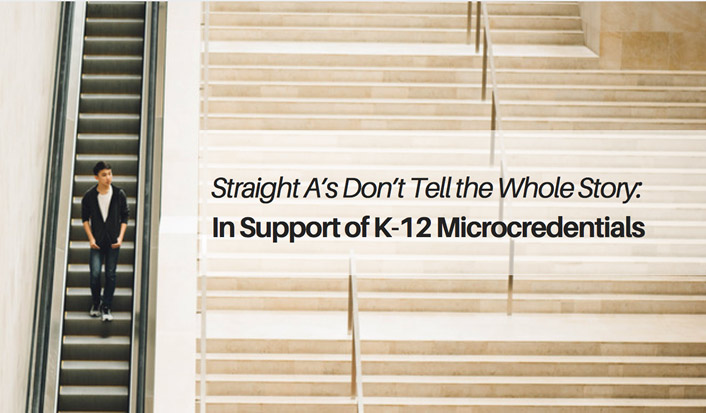by Kristi DePaul (re-posted from Educause Review)

These days, microcredentials represent an oft-explored topic in higher education; they are the subject of academic working groups, and regularly appear as a topic in major education conferences. They come in a variety of forms, from digital badges to nanodegrees, and their popularity has even spawned a number of related edtech companies.
The same cannot be said, however, for K-12…yet. But there are nascent collaborations that are starting to show promise in this area.
As assistant dean for community engagement at University of California, San Diego Extension and the director of the campus’ pre-collegiate and career preparation programs, Ed Abeyta understands the inherent disconnect between students’ actual high school performance and college admissions teams’ interpretations. Many students’ competencies are getting lost in translation, in fact, despite the emergence of a relatively simple and thoroughly contemporary solution.
“Frankly, student achievement comes in different categories: completing a course is one example, but there are other, what we call ‘achievable moments,’ aren’t as finite in nature,” Abeyta said. “But students deserve to have these milestones acknowledged, if not only because they can serve as legitimate signposts to students’ true skills and abilities.”
Rewarding or recognizing a student based on a rubric is like watching a 3D film without the special glasses. You’re missing another dimension.
Abeyta is working with San Diego Unified School District as part of a K-12/university partnership on badging. What they develop won’t be a one-size-fits-all solution: one set of badges will be created for high school students, one for undergraduates, and one for graduate students.
“We look at skills competencies, motivators, and instances in which we can have a sense of accountability,” Abeyta said. These can even include attendance.
“Each competency is defined as part of a greater competency ecosystem. This means that we’ll start to see a wide variety of competencies, and also that the relevance of this project will require a lot of local effort.”
What occasionally derails such efforts is an overemphasis on the superficial, he says — on badges’ form rather than function. “You can put a group of highly intelligent people in a room, and they’ll debate about color palettes and badge designs versus the types of skills, knowledge and applications that need to be captured and ultimately, better understood.”
Abeyta explains that badging combines a social media element and academic connection being verified. From a social perspective, there are clear advantages to displaying and sharing visible proof of one’s work, as our professional lives and networks exist as much in the digital realm as they do in the physical world.
And while ‘verified’ doesn’t mean that a given skill awarded within a badge will appear on a student’s official academic transcript, it does allow for a more holistic representation of their skills and experiences, mixing nontraditional and traditional learning.
For example, students can showcase badges that represent service projects, which have been valuable to a community and can involve significant skill acquisition, among other types of experiences and accomplishments like STEAM workshops that would otherwise go undocumented.
“There’s a lifecycle and learning process, and in it, we’re not exactly sure where accountability comes into play, despite that being quantified during a student’s academic experience. Yet it matters to employers.”
Prospective employers and college admissions staff can view a host of qualitative comments within the badging community, speaking to those elements of a portfolio that don’t appear on a transcript. Then there’s the metadata itself encoded within the badges. “This is a kind of transparency that can’t be achieved by traditional means,” Abeyta said.
High school students in the San Diego Unified School district are learning how to use LinkedIn and aggregating their professional experiences with badges, alongside the more typical attention-turning activities of securing driver’s licenses, taking exams, and attending football games or the prom.
“The fact that we can help students preparing themselves for jobs that don’t exist yet is pretty exciting,” he added. “Our job is helping them to unlock their genius and be happy in the work, which leads to fulfillment and ultimately, to success.”
Abeyta stressed that the platform isn’t as important as the application. Each platform’s competencies consist of basic logic skills that students need, combined with soft skills.
He noted that the industry itself is still evolving.
“Right now, badging is a boutique industry that isn’t united. There’s no think tank gathering. As a qualitative researcher, I look at conferences and try to pick up on themes across many higher ed, financial aid and student affairs conferences — groups that bridge gap between K12 and HE — and I’m seeing more badging-themed workshops cropping up over the past few years.”
In his 22 years at UC San Diego, Abeyta has seen a lot of incoming freshmen making their way, and looks forward to how badges can one day improve their employment prospects.
“It’s amazing what happens when something is built: everyone gravitates when you put the time in,” he said.
“In education, we’re no longer built to be a ‘conveyor belt system’ anymore; at the same time, we’re reconnecting with broader concept of learning. There are skills beyond math and writing that make us competitive. Our edge in the United States is not to say we’re better than others in these areas. Rather, it has always been creativity and innovation. We’re a little weird; that’s our advantage. We’re stubborn and want to do things differently. Our strength is our insubordination.”